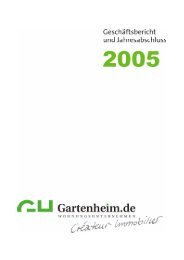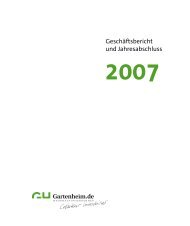analysis of the influences of solar radiation and façade glazing ...
analysis of the influences of solar radiation and façade glazing ...
analysis of the influences of solar radiation and façade glazing ...
Create successful ePaper yourself
Turn your PDF publications into a flip-book with our unique Google optimized e-Paper software.
4.1 Summary 99<br />
4 Summary <strong>and</strong> conclusions<br />
4.1 Summary<br />
The duty <strong>of</strong> environmental protection <strong>and</strong> its sustainable development requires <strong>the</strong> design<br />
<strong>of</strong> energy-efficient buildings. Computer-based simulations play a very important role in<br />
this process. Additionally, this type <strong>of</strong> <strong>analysis</strong> can be useful in achieving <strong>the</strong>rmal comfort<br />
in <strong>the</strong> occupied spaces.<br />
Three co-operative apartment houses, which are currently being built in Hannover, are <strong>the</strong><br />
object <strong>of</strong> this dissertation. Each <strong>of</strong> <strong>the</strong> five storey buildings consists <strong>of</strong> nineteen<br />
apartments, a staircase <strong>and</strong> a storeroom for each home. The house envelope was designed<br />
for <strong>the</strong> optimal utilization <strong>of</strong> <strong>solar</strong> <strong>radiation</strong> energy during <strong>the</strong> heating season. A HVAC<br />
system <strong>of</strong> <strong>the</strong> considered buildings consists <strong>of</strong> mechanical ventilation, a heat recovery<br />
exchanger with its economizer controller <strong>and</strong> a combination <strong>of</strong> baseboard convective<br />
heaters <strong>and</strong> floor heating.<br />
In order to prove <strong>the</strong> hypo<strong>the</strong>sis, three basic research methods were chosen. Firstly,<br />
detailed literature research was conducted to identify <strong>the</strong> current published knowledge<br />
concerning <strong>the</strong> impact <strong>of</strong> <strong>solar</strong> <strong>radiation</strong> on <strong>the</strong> <strong>the</strong>rmal behavior <strong>of</strong> buildings. Computer<br />
simulation technique, which grows in popularity each year, was selected as <strong>the</strong> next<br />
investigation method. Additionally, experimental investigations were carried out to<br />
determine <strong>the</strong> <strong>the</strong>rmal performance <strong>of</strong> <strong>the</strong> considered external wall <strong>and</strong> <strong>the</strong>n for calibrating<br />
a building simulation s<strong>of</strong>tware.<br />
The bibliographic review <strong>and</strong> state-<strong>of</strong>-<strong>the</strong>-art technology was focused on <strong>solar</strong> heat gain<br />
through windows, <strong>the</strong> simulation <strong>of</strong> building <strong>the</strong>rmal behavior, <strong>the</strong> influence <strong>of</strong> <strong>the</strong><br />
building envelope construction on energy consumption <strong>and</strong> modelling <strong>and</strong> designing <strong>solar</strong><br />
domestic hot water systems.<br />
The detailed simulation method was chosen, as recommended in <strong>the</strong> literature, as <strong>the</strong> best<br />
tool for <strong>the</strong> research <strong>of</strong> active <strong>solar</strong> domestic hot water, heating, ventilation <strong>and</strong> air<br />
conditioning systems. Simultaneous modelling <strong>of</strong> building <strong>the</strong>rmal behavior <strong>and</strong> <strong>the</strong><br />
operation <strong>of</strong> plant <strong>and</strong> HVAC systems was employed by <strong>the</strong> author to approach simulation<br />
results with physical reality. The EnergyPlus V3-0, as <strong>the</strong> verified <strong>and</strong> fully validated tool,<br />
was chosen from a wide variety <strong>of</strong> simulation programs. This s<strong>of</strong>tware with structured,<br />
modular code models combines heat <strong>and</strong> mass transfer, simulates multi-zone airflow <strong>and</strong><br />
operates heating, cooling <strong>and</strong> ventilating systems in all kinds <strong>of</strong> buildings for long periods<br />
<strong>of</strong> time under varying conditions.<br />
First <strong>of</strong> all, a survey <strong>of</strong> problems concerned with <strong>the</strong> subject <strong>of</strong> <strong>the</strong> current dissertation in<br />
order to perform a more detailed <strong>and</strong> complex <strong>analysis</strong> <strong>of</strong> <strong>the</strong>rmal behavior <strong>of</strong> buildings





